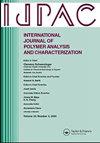Enhancing geopolymer concrete strength with sodium hydroxide using Gegenbauer graph neural networks approach
IF 1.6
4区 工程技术
Q4 POLYMER SCIENCE
International Journal of Polymer Analysis and Characterization
Pub Date : 2025-10-03
DOI:10.1080/1023666X.2025.2490782
引用次数: 0
Abstract
An eco-friendly and inventive alternative to cement-based concrete is geopolymer concrete (GPC) due to its reduced carbon footprint, as it completely replaces cement. Despite their environmental benefits, the mechanical performance of GPC is highly sensitive to the mix of proportions and curing conditions, presenting significant challenges in achieving consistent strength. To enhance the strength and mechanical properties of GPC with sodium hydroxide (NaOH), a unique approach using Gegenbauer graph neural networks (GGNN) is presented in this work. The main objectives of this study include reducing CO2 emissions. The strength of GPC with NaOH is predicted using GGNN. The GGNN method is also used to analyze the mechanical properties of GPC under different NaOH molarities and different ratios of sodium silicate to NaOH. The proposed method is simulated in MATLAB and is compared with existing methods like long short-term memory (LSTM), artificial neural network (ANN), and back propagation neural network (BPNN). It is found that the oven-cured GPC achieved better mechanical strength compared to the ambient-cured GPC. The proposed model attained the highest compressive strength (CS) of 75.42 MPa along with a high correlation coefficient of 0.9871 compared to the previous studies. In contrast to the existing methods, the proposed model achieved a high prediction accuracy of 98.5% along with a low CO2 emission of 7% demonstrating its superior performance in accurately predicting the mechanical strength and reducing carbon footprints. This indicates the robustness and reliability of the proposed model for optimizing material properties and advancing the field of sustainable construction materials.
用Gegenbauer图神经网络方法提高氢氧化钠地聚合物混凝土强度
地聚合物混凝土(GPC)是水泥基混凝土的环保和创新替代品,因为它可以完全取代水泥,减少碳足迹。尽管具有环境效益,但GPC的机械性能对混合比例和固化条件非常敏感,这对实现一致的强度提出了重大挑战。为了提高氢氧化钠(NaOH) GPC的强度和力学性能,本文提出了一种使用Gegenbauer图神经网络(GGNN)的独特方法。这项研究的主要目标包括减少二氧化碳的排放。用GGNN预测了含NaOH的GPC的强度。采用GGNN方法分析了不同NaOH摩尔浓度和水玻璃与NaOH的不同配比下GPC的力学性能。在MATLAB中对该方法进行了仿真,并与长短期记忆(LSTM)、人工神经网络(ANN)和反向传播神经网络(BPNN)等现有方法进行了比较。结果表明,与常温固化GPC相比,高温固化GPC具有更好的机械强度。与已有研究相比,该模型获得了最高的抗压强度(CS)为75.42 MPa,相关系数为0.9871。与现有方法相比,该模型预测精度高达98.5%,二氧化碳排放量低至7%,在准确预测机械强度和减少碳足迹方面具有优越的性能。这表明所提出的模型对于优化材料性能和推进可持续建筑材料领域具有鲁棒性和可靠性。
本文章由计算机程序翻译,如有差异,请以英文原文为准。
求助全文
约1分钟内获得全文
求助全文
来源期刊
CiteScore
3.50
自引率
5.30%
发文量
37
审稿时长
1.6 months
期刊介绍:
The scope of the journal is to publish original contributions and reviews on studies, methodologies, instrumentation, and applications involving the analysis and characterization of polymers and polymeric-based materials, including synthetic polymers, blends, composites, fibers, coatings, supramolecular structures, polysaccharides, and biopolymers. The Journal will accept papers and review articles on the following topics and research areas involving fundamental and applied studies of polymer analysis and characterization:
Characterization and analysis of new and existing polymers and polymeric-based materials.
Design and evaluation of analytical instrumentation and physical testing equipment.
Determination of molecular weight, size, conformation, branching, cross-linking, chemical structure, and sequence distribution.
Using separation, spectroscopic, and scattering techniques.
Surface characterization of polymeric materials.
Measurement of solution and bulk properties and behavior of polymers.
Studies involving structure-property-processing relationships, and polymer aging.
Analysis of oligomeric materials.
Analysis of polymer additives and decomposition products.

 求助内容:
求助内容: 应助结果提醒方式:
应助结果提醒方式:


